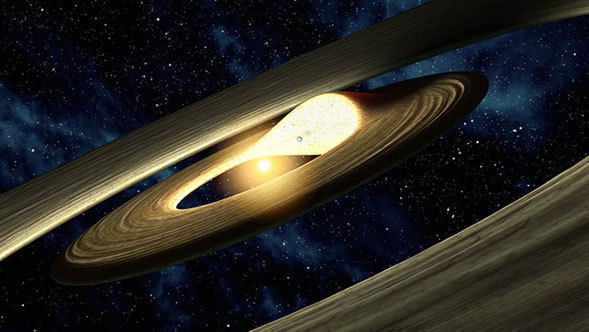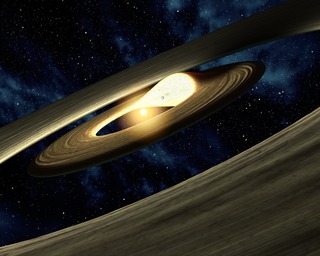
News Release • September 23rd, 2009 • ssc2009-18 •
PASADENA, Calif. Astronomers have witnessed odd behavior around a young star. Something, perhaps another star or a planet, appears to be pushing a clump of planet-forming material around. The observations, made with NASA's Spitzer Space Telescope, offer a rare look into the early stages of planet formation.
Planets form out of swirling disks of gas and dust. Spitzer observed infrared light coming from one such disk around a young star, called LRLL 31, over a period of five months. To the astronomers' surprise, the light varied in unexpected ways, and in as little time as one week. Planets take millions of years to form, so it's rare to see anything change on time scales we humans can perceive.
One possible explanation is that a close companion to the star - either a star or a developing planet - could be shoving planet-forming material together, causing its thickness to vary as it spins around the star.
"We don't know if planets have formed, or will form, but we are gaining a better understanding of the properties and dynamics of the fine dust that could either become, or indirectly shape, a planet," said James Muzerolle of the Space Telescope Science Institute, Baltimore, Md. Muzerolle is first author of a paper accepted for publication in the Astrophysical Journal Letters. "This is a unique, real-time glimpse into the lengthy process of building planets."
One theory of planet formation suggests that planets start out as dusty grains swirling around a star in a disk. They slowly bulk up in size, collecting more and more mass like sticky snow. As the planets get bigger and bigger, they carve out gaps in the dust, until a so-called transitional disk takes shape with a large doughnut-like hole at its center. Over time, this disk fades and a new type of disk emerges, made up of debris from collisions between planets, asteroids and comets. Ultimately, a more settled, mature solar system like our own forms.
Before Spitzer was launched in 2003, only a few transitional disks with gaps or holes were known. With Spitzer's improved infrared vision, dozens have now been found. The space telescope sensed the warm glow of the disks and indirectly mapped out their structures.
Muzerolle and his team set out to study a family of young stars, many with known transitional disks. The stars are about two to three million years old and about 1,000 light-years away, in the IC 348 star-forming region of the constellation Perseus. A few of the stars showed surprising hints of variations. The astronomers followed up on one, LRLL 31, studying the star over five months with all three of Spitzer's instruments.
The observations showed that light from the inner region of the star's disk changes every few weeks, and, in one instance, in only one week. "Transition disks are rare enough, so to see one with this type of variability is really exciting," said co-author Kevin Flaherty of the University of Arizona, Tucson.
Both the intensity and the wavelength of infrared light varied over time. For instance, when the amount of light seen at shorter wavelengths went up, the brightness at longer wavelengths went down, and vice versa.
Muzerolle and his team say that a companion to the star, circling in a gap in the system's disk, could explain the data. "A companion in the gap of an almost edge-on disk would periodically change the height of the inner disk rim as it circles around the star: a higher rim would emit more light at shorter wavelengths because it is larger and hot, but at the same time, the high rim would shadow the cool material of the outer disk, causing a decrease in the longer-wavelength light. A low rim would do the opposite. This is exactly what we observe in our data," said Elise Furlan, a co-author from NASA's Jet Propulsion Laboratory, Pasadena, Calif.
The companion would have to be close in order to move the material around so fast - about one-tenth the distance between Earth and the sun.
The astronomers plan to follow up with ground-based telescopes to see if a companion is tugging on the star hard enough to be perceived. Spitzer will also observe the system again in its "warm" mission to see if the changes are periodic, as would be expected with an orbiting companion. Spitzer ran out of coolant in May of this year, and is now operating at a slightly warmer temperature with two infrared channels still functioning.
"For astronomers, watching anything in real-time is exciting," said Muzerolle. "It's like we're biologists getting to watch cells grow in a petri dish, only our specimen is light-years away."
Other authors are Zoltan Balog, Max Planck Institute for Astronomy, Germany; Paul S. Smith and George Rieke, University of Arizona; Lori Allen, National Optical Astronomy Observatory, Tucson; Nuria Calvet, University of Michigan, Ann Arbor; Paola D'Alessio, National Autonomous University of Mexico; S. Thomas Megeath, University of Toledo, Ohio; August Muench, Harvard-Smithsonian Center for Astrophysics, Cambridge; William H. Sherry, National Solar Observatory, Tucson.





